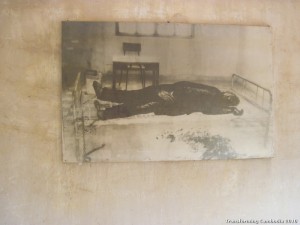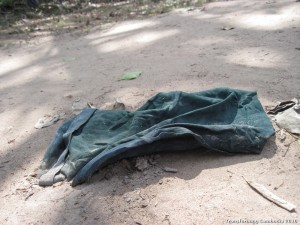Those who mourn …

 In some of the rooms at the Tuol Sleng Genocide Museum, there are iron beds, with shackles and instruments of torture displayed on them. On the walls of these rooms are large photographs of people stretched out on these beds, their bodies contorted and their faces twisted into grimaces of pain. They look shocked at the degree of misery they have endured. These are the people who have been tortured in these rooms. Tuol Sleng was also known as Security Office 21 in Democratic Kampuchea during the years the Khmer Rouge were in control of Cambodia. A former high school, s-21 was where 14,000 prisoners–most of them educated or wealthy people–were tormented with beatings, electrocution and various kinds of water torture. In other rooms of the prison are cells. And in other rooms are the faces–rows and rows of
In some of the rooms at the Tuol Sleng Genocide Museum, there are iron beds, with shackles and instruments of torture displayed on them. On the walls of these rooms are large photographs of people stretched out on these beds, their bodies contorted and their faces twisted into grimaces of pain. They look shocked at the degree of misery they have endured. These are the people who have been tortured in these rooms. Tuol Sleng was also known as Security Office 21 in Democratic Kampuchea during the years the Khmer Rouge were in control of Cambodia. A former high school, s-21 was where 14,000 prisoners–most of them educated or wealthy people–were tormented with beatings, electrocution and various kinds of water torture. In other rooms of the prison are cells. And in other rooms are the faces–rows and rows of  photographs of faces of the slain. They are not contorted in misery. They are beautiful.
photographs of faces of the slain. They are not contorted in misery. They are beautiful.
At the Choeung Ek Genocidal Center, there is a large memorial built in the form of a temple. It is filled with human skulls, 8,000 of them that have been dug up out of the ground. You can see the skulls through the glass walls of the building.
When you walk the grounds around the memorial, the path wanders up and down, and there are bits of cloth sticking out of the ground. They are the remains of the clothes of the approximately 20,000 victims who were killed there. Choeung Ek is one site of the Cambodian killing fields, so when you walk the paths, you are walking in a graveyard. 
Keeping pace with you, running along the other side of the fence are the children, and it sounds like they’re chanting. What they are saying is delivered in a low hum, all on one note like Indian music: “Madame, please, yougivememoneyMadame, please, yougivememoneyforschool?Money for the school,forthebook?Please,madame,you give?”
The beds, the cells, the skulls, the bits of old shirts and trousers and the children running alongside all tell the same story. It is because of Tuol Sleng
and Choeung Ek and the begging children that the people we have visited are working so hard in Cambodia during these years. When the Khmer Rouge took power and declared Year Zero, they outlawed everything that makes life worth living: education, religion, art, music, beauty–everything lovely. And the people who were educated or religious or artistic or musical or beautiful they killed in horrible ways. And the children who run along the fence, chanting for money, children who should be in school, needed the guidance of that generation, a generation that was erased. These children should be artists and musicians and intellectuals people and people of God.
An even larger part of the story remains buried. For Tuol Sleng is only the most notorious of the prisons–mainly because here the crimes were so well documented. There were around 200 such prisons in Cambodia, and at these sites, more victims were killed than were at Tuol Sleng. When S.K. Lee visited Grand Rapids last summer, he was talking about the Khmer Rouge. “They kill their own people,” he said in shocked disbelief.” S.K. has worked in Cambodia for eight years: ‘There’s just no getting used to genocide.
We visited Tuol Sleg and Choeung Ek this morning. Some of our students had a hard time of it today …
We will be at the farm, and incommunicado, until Thursday.
I can only imagine the hard time they are having. It is difficult to sit and home and read about it.
Yes, I agree with Ann. And this is the part of the trip that I knew in my heart was so very necessary and yet would affect everyone for the rest of their lives. We will pray for everyone. Love to all, and prayers, Arda
Praying …
Thanks, Phil.